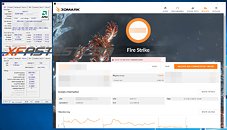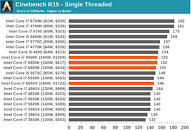Raevenlord
News Editor
- Joined
- Aug 12, 2016
- Messages
- 3,755 (1.20/day)
- Location
- Portugal
| System Name | The Ryzening |
|---|---|
| Processor | AMD Ryzen 9 5900X |
| Motherboard | MSI X570 MAG TOMAHAWK |
| Cooling | Lian Li Galahad 360mm AIO |
| Memory | 32 GB G.Skill Trident Z F4-3733 (4x 8 GB) |
| Video Card(s) | Gigabyte RTX 3070 Ti |
| Storage | Boot: Transcend MTE220S 2TB, Kintson A2000 1TB, Seagate Firewolf Pro 14 TB |
| Display(s) | Acer Nitro VG270UP (1440p 144 Hz IPS) |
| Case | Lian Li O11DX Dynamic White |
| Audio Device(s) | iFi Audio Zen DAC |
| Power Supply | Seasonic Focus+ 750 W |
| Mouse | Cooler Master Masterkeys Lite L |
| Keyboard | Cooler Master Masterkeys Lite L |
| Software | Windows 10 x64 |
Another day, another leak: the folks at XFastest have indeed been the fastest to leak images of an actual Ryzen 7 1700X processor, with pictures of the processor's IHS and pin area running rampant throughout the Internet (the Ryzen chip is located to the right in both pictures, with a sample of AMD's previous-generation FX CPUs on the left side for comparison sake).
While revealing shots may have their appeal, it's the benchmarking portion that most of us are expectant about. Until actual reviews are out, we're left nothing more than these leaks (which should be taken with appropriate amounts of salt). In this case, benchmarks of AMD's upcoming Ryzen 7 1700X have been released, showing just how the upcoming CPU delivers in 3D Mark Fire Strike, CPU Mark and Cinebench R15.


Let's take it from the top: on Fire Strike's Physics test, the Ryzen 7 1700X scores a grand total of 17,916 points. CPU-Z screenshots running alongside the completed benchmark show us a 3.89 GHz clockspeed (up 400 MHz from the chip's base speed, at 3.4 GHz). The multiplier is set at 39x (4 units higher than the base 35x), though for now it is unclear if this was done through manual overclocking (remember, all Ryzen CPUs will come multiplier unlocked,) or through the chip's own XFR automated overclocking.
I'll go out on a limb here and say that this is XFR working as it should - remember, rated XFR speeds for the Ryzen 7 1700X are of 3.8+ GHz, meaning it can hit the mentioned 3.89 GHz by itself, provided sufficient cooling is at hand. CPU voltage in this test appears at 0.672 V. In this test, like in all others from this leak, the CPU was running with 16 GB of DDR4 memory running at 2132 MHz frequency.

Moving on to the CPU Mark portion of the leaked benchmarks, we see a couple differences from the Fire Strike test. For one, the CPU clockspeed as reported by CPU-Z fell by 400MHz towards 3.49 GHz, with the multiplier taking a proportionate hit (35x). The voltage has also gone down though, from the previous 0.672 V to a more conservative 0.536 V - another circumstantial piece of evidence that we are looking at XFR toying with voltage and multiplier values. On this test, the 1700X scores 583 points.

Now on to one of the kings on multi-threaded and single-threaded benchmarking: Cinebench R15. Here, the 1700X is shown as achieving 1537 points on the multi-threaded test, and 154 points on the single-threaded one. It is worth noting that Cinebench R15 reports the 1700X's base clock speed of 3.40 GHz, while again CPU-Z reports 3.49 GHz with a 0.672 V.

Let me just take a slight tangent here whilst saying that this variation in clockspeeds and voltages is probably revealing of the leak's source screenshotting results after different time intervals have elapsed since a given test's completion. Soon enough for the clockspeeds to remain at the XFR frequency (Fire Strike's 3.89 GHz); when both clockspeed and voltage have already decreased (CPU Mark); and when the boost clocks decrease but voltage lingers (Cinebench R15).
Let's just take a little more critical approach regarding these Cinebench results; compare the 1700X's scores with these, taken from Anandtech:


Some comments: AMD's 1700X achieves virtually identical scores to Intel's 6900K CPU on both tests (loses slightly on the multi-threaded test, but eeks out a win on the single-threaded one) once you take variabilty into account. We also can't forget how the test systems differ in terms of memory specs and all those other small things, which still end up affecting the final score. Whether you think this variability favors AMD's 1700X or Intel's 6900K in this particular scenario, there is one thing variability can't account for: the 55 W difference between rated TDP on AMD's 1700X (95 W) and Intel's 6900K (140 W).
Another thing that can't (apparently) be denied is the enormous leap in performance compared to AMD's now defunct Bulldozer architecture (and later refinements). The 1700X at 95 W TDP scores the vaunted 40% more in the single-threaded test than AMD's FX 9590 running at 5 GHz and at 220 W (!!) TDP, with 154 points against the FX 9590's tiny 110. This, allied to the 1700X's use of SMT with its 16 logical threads, also helps put into perspective how AMD managed to achieve a 111% boost in the multi-threaded score compared to the FX 9590 (1537 on the 1700X, 728 on the FX 9590). And this happens, again, despite the 9590 running at 4.7 GHz base and 5 GHz boost, whilst having a TDP rated at 125W more than the 1700X. You don't have to ask me for evidence. Look here:


However one cuts this, these leaks (assuming they're remotely accurate) truly bring to light the enormous engineering challenge AMD had to surpass on its way to Ryzen: the enormity of the task for Jim Keller and company in bringing a competitive, efficient architecture to market despite AMD's inherent difficulties in funding, manufacturing... And on and on. That they managed to engineer an architecture such as this, which apparently gives Intel a run for its money even on the efficiency metrics, is nothing short of extraordinary. Add to that the potential for a many-core democratization even on the entry-level, and we could also see an important push towards more parallelized applications, taking advantage of 4-core solutions at the entry level, finally doing away with the overreaching dual core, four-thread CPUs that have more than outstayed their welcome.
Source: Anandtech
View at TechPowerUp Main Site
While revealing shots may have their appeal, it's the benchmarking portion that most of us are expectant about. Until actual reviews are out, we're left nothing more than these leaks (which should be taken with appropriate amounts of salt). In this case, benchmarks of AMD's upcoming Ryzen 7 1700X have been released, showing just how the upcoming CPU delivers in 3D Mark Fire Strike, CPU Mark and Cinebench R15.


Let's take it from the top: on Fire Strike's Physics test, the Ryzen 7 1700X scores a grand total of 17,916 points. CPU-Z screenshots running alongside the completed benchmark show us a 3.89 GHz clockspeed (up 400 MHz from the chip's base speed, at 3.4 GHz). The multiplier is set at 39x (4 units higher than the base 35x), though for now it is unclear if this was done through manual overclocking (remember, all Ryzen CPUs will come multiplier unlocked,) or through the chip's own XFR automated overclocking.
I'll go out on a limb here and say that this is XFR working as it should - remember, rated XFR speeds for the Ryzen 7 1700X are of 3.8+ GHz, meaning it can hit the mentioned 3.89 GHz by itself, provided sufficient cooling is at hand. CPU voltage in this test appears at 0.672 V. In this test, like in all others from this leak, the CPU was running with 16 GB of DDR4 memory running at 2132 MHz frequency.

Moving on to the CPU Mark portion of the leaked benchmarks, we see a couple differences from the Fire Strike test. For one, the CPU clockspeed as reported by CPU-Z fell by 400MHz towards 3.49 GHz, with the multiplier taking a proportionate hit (35x). The voltage has also gone down though, from the previous 0.672 V to a more conservative 0.536 V - another circumstantial piece of evidence that we are looking at XFR toying with voltage and multiplier values. On this test, the 1700X scores 583 points.

Now on to one of the kings on multi-threaded and single-threaded benchmarking: Cinebench R15. Here, the 1700X is shown as achieving 1537 points on the multi-threaded test, and 154 points on the single-threaded one. It is worth noting that Cinebench R15 reports the 1700X's base clock speed of 3.40 GHz, while again CPU-Z reports 3.49 GHz with a 0.672 V.

Let me just take a slight tangent here whilst saying that this variation in clockspeeds and voltages is probably revealing of the leak's source screenshotting results after different time intervals have elapsed since a given test's completion. Soon enough for the clockspeeds to remain at the XFR frequency (Fire Strike's 3.89 GHz); when both clockspeed and voltage have already decreased (CPU Mark); and when the boost clocks decrease but voltage lingers (Cinebench R15).
Let's just take a little more critical approach regarding these Cinebench results; compare the 1700X's scores with these, taken from Anandtech:


Some comments: AMD's 1700X achieves virtually identical scores to Intel's 6900K CPU on both tests (loses slightly on the multi-threaded test, but eeks out a win on the single-threaded one) once you take variabilty into account. We also can't forget how the test systems differ in terms of memory specs and all those other small things, which still end up affecting the final score. Whether you think this variability favors AMD's 1700X or Intel's 6900K in this particular scenario, there is one thing variability can't account for: the 55 W difference between rated TDP on AMD's 1700X (95 W) and Intel's 6900K (140 W).
Another thing that can't (apparently) be denied is the enormous leap in performance compared to AMD's now defunct Bulldozer architecture (and later refinements). The 1700X at 95 W TDP scores the vaunted 40% more in the single-threaded test than AMD's FX 9590 running at 5 GHz and at 220 W (!!) TDP, with 154 points against the FX 9590's tiny 110. This, allied to the 1700X's use of SMT with its 16 logical threads, also helps put into perspective how AMD managed to achieve a 111% boost in the multi-threaded score compared to the FX 9590 (1537 on the 1700X, 728 on the FX 9590). And this happens, again, despite the 9590 running at 4.7 GHz base and 5 GHz boost, whilst having a TDP rated at 125W more than the 1700X. You don't have to ask me for evidence. Look here:


However one cuts this, these leaks (assuming they're remotely accurate) truly bring to light the enormous engineering challenge AMD had to surpass on its way to Ryzen: the enormity of the task for Jim Keller and company in bringing a competitive, efficient architecture to market despite AMD's inherent difficulties in funding, manufacturing... And on and on. That they managed to engineer an architecture such as this, which apparently gives Intel a run for its money even on the efficiency metrics, is nothing short of extraordinary. Add to that the potential for a many-core democratization even on the entry-level, and we could also see an important push towards more parallelized applications, taking advantage of 4-core solutions at the entry level, finally doing away with the overreaching dual core, four-thread CPUs that have more than outstayed their welcome.
Source: Anandtech
View at TechPowerUp Main Site
Last edited:



 .
.




